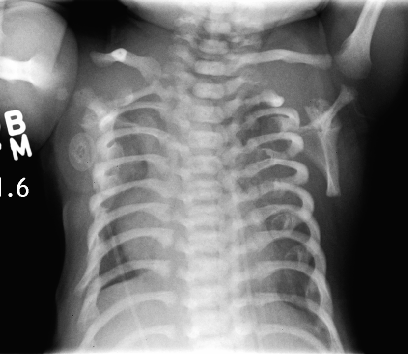Jeune Syndrome

Jeune syndrome, also called asphyxiating thoracic dystrophy, is a short-rib dysplasia characterized by a narrow thorax, short limbs and radiological skeletal abnormalities including 'trident' aspect of the acetabula and metaphyseal changes.
Epidemiology
Annual incidence at birth is unknown but is estimated to be 1-5/500,000.
Clinical description
The syndrome is recognizable during the antenatal period or at birth. In rare cases, postaxial polydactyly may also be present. The narrow thorax may cause neonatal respiratory failure, and may be associated with persistent respiratory manifestations. Some cases are severe while others have a benign course. The growth rate is variable but may be almost normal. Hepatic and renal failure has been reported in rare cases (liver fibrosis or nephronophthisis) occurring at any age. Retinal pigmentary degeneration could also be observed. Intellectual development is normal.
Etiology
The molecular basis of the syndrome has been partially elucidated indicating involvement of the IFT80 (3q25.33), DYNC2H1 (11q22.3), WDR19 (4p14) and TTC21B (2q24.3) genes, each encoding an intraflagellar transport protein, which confirms that Jeune syndrome belongs to the ciliopathies group. Mutations in other genes may also be implicated in the disease and remain to be identified.
Diagnostic methods
The diagnosis is based on radiologic findings: ribs are short and the pelvis has an abnormal morphology, with a horizontal acetabular roof and a trident aspect formed by a median protrusion and two lateral spurs. Hands are normal or short with possible cone-shaped epiphyses in the phalanges.
Differential diagnosis
Differential diagnosis should include thoracolaryngopelvic dysplasia, Ellis-van Creveld syndrome, Sensenbrenner syndrome and paternal uniparental disomy of chromosome 14 (see these terms).
Antenatal diagnosis
Molecular diagnosis must be confirmed in the proband before proposing prenatal molecular testing. In other cases, only a careful antenatal ultrasound examination can detect the disease.
Genetic counseling
The syndrome is transmitted as an autosomal recessive trait. The recurrence risk is 25% for every pregnancy after the birth of an affected child.
Management and treatment
Treatment consists of management of respiratory infections, which may lead to severe complications. Renal and hepatic function should be monitored regularly, and retinal examination performed.
Prognosis
Prognosis is highly variable depending of the visceral associated diseases, and the risk of severe respiratory complications decreases after 2 years of age.